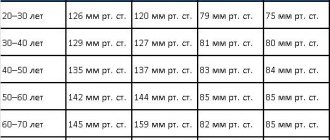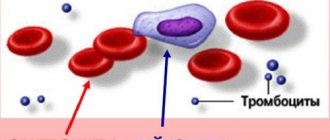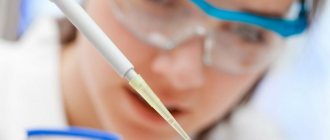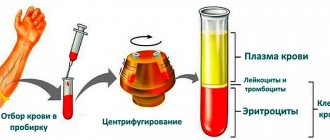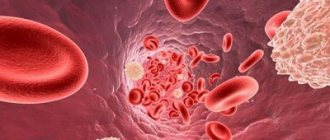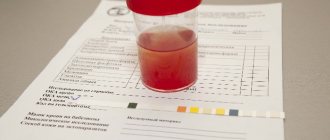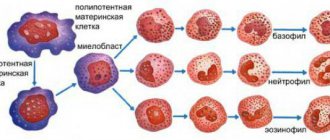The prothrombin index is a diagnostic indicator that demonstrates the speed and quality of blood clotting. The calculations are based on the proportional ratio of the time required to change the properties of the plasma and the period taken as the conventional norm.
Next, based on the calculation results, a certain percentage is obtained, which becomes the desired value. Adequate levels are determined by age, but in general, there are no significant differences between years.
The prothrombin index (abbreviated PTI) is used in the practice of hematologists for early examination and detection of various forms of diseases and coagulopathies.
Treatment is not always necessary. Transient types of disturbance are possible. Next, corrective measures are prescribed as needed. Strictly under the supervision of doctors.
General information about prothrombin
The coagulation system and the factors that are antagonistic to it are always in a state of dynamic equilibrium. That is, changes in one system should be responded to in a friendly manner by the second. This is a biological law that maintains the stability of the body in constantly changing conditions.
The blood coagulation system is a collection of enzymes. These are mostly protein structures. All of them are sequentially involved in a chain of chemical reactions, launching and activating subsequent ones. One of the main coagulation factors is prothrombin. This protein is otherwise called factor 2 or FII.
It is synthesized, like many other proteins, in liver cells. The process occurs with the help of vitamin K. Prothrombin contains about 18 amino acid residues, but belongs to mixed proteins - glycoproteins.
The role of prothrombin is key in the coagulation process. It acts as an activator of the main protein that forms the “plug” - fibrinogen. This inactive precursor is converted into functioning thrombin by the action of prothrombin. This stops bleeding.
The prothrombin index is one of the most important indicators of hemostasis, which is included in the examination standards for almost every hospitalization. Like INR, it allows you to evaluate the so-called external coagulation pathway, which is implemented when the integrity of the vascular wall is violated.
PTI, the norm for women by age (the table clearly shows its dynamics throughout life) is determined as follows. To calculate, it is necessary to determine the time during which the patient’s plasma coagulates.
The second indicator is the plasma clotting time in the control tube. The ratio of the second indicator to the first in the form of a quotient (divide one by the other) will show the index value.
The international normalized ratio is calculated somewhat the other way around. The dividend is the patient’s prothrombin time, determined using the analysis.
The divisor is the time during which the control plasma coagulates. This number is also multiplied by a special index called MICH. Otherwise they are referred to as the international sensitivity index. This is a value that is constant for certain reactive systems.
What is the coagulation system
The hemostasis system is very complex, involving many tissue and serum factors. Its launch is really similar to a cascade: it is a chain of reactions, each subsequent link of which is accelerated by additional enzymes.
A simplified blood coagulation scheme looks like this: thromboplastin is released from the damaged endothelium, with the participation of calcium ions and vitamin K, it activates prothrombin. Prothrombin is converted to active thrombin, which in turn triggers the formation of insoluble fibrin from soluble fibrinogen. This process is completed by the stage of retraction of the blood clot, that is, its compaction and the actual blockage of the damage.
At each stage, many more factors are involved in this scheme. In total, there are 13 plasma and 22 platelet types.
When is the test scheduled?
PTI, the norm for women by age (the table exists to allow comparison of research results with it) is compared with the actual data obtained as a result of the prescribed examination.
The method of determining PTI and INR in combination with the study of activated partial thromboplasty time, as well as blood fibrinogen concentration, is a screening method for identifying hemostasis disorders. And yet, there are situations when the values of these coefficients make it possible to diagnose other pathologies.
Considering that prothrombin, like other coagulation factors, is synthesized in the liver, it is clear that its content in the bloodstream will be determined by the functional reserves of the organ. In other words, if there is pathology, then this will invariably be reflected in the level of PTI and INR.
If liver cirrhosis is suspected, a blood test is required to determine the prothrombin index and international normalized ratio. In addition, these indices can be taken into account to assess the stage of the disease, when compensation or decompensation of the organ occurs. Not only in cirrhosis, PTI and INR change.
This phenomenon can be detected in hepatitis as part of the cytolytic syndrome (massive cell death due to an aggressive inflammatory process).
The next important indication for analysis is the upcoming surgical intervention. For the operating surgeon, and even more so for the anesthesiologist who will decide on the type of anesthesia, blood coagulation parameters will be extremely important.
Therefore, in addition to INR and IPT, the following studies are prescribed:
- APTT;
- blood fibrinogen;
- PV;
- blood clotting time.
Thus, doctors have a complete understanding of the state of the coagulation/anticoagulation system in order to be warned and prepared for what may happen during surgical treatment.
Vascular diseases associated with the formation of blood clots in various segments of the arterial or venous bed are also on the list of indications for studying IPT and INR.
This can be thrombosis of the veins, pulmonary artery (a life-threatening disease - PE), as well as the arteries of the brain with the formation of a stroke and the vessels of the heart with the development of a heart attack. PTI and INR in these conditions are important for dynamic monitoring of the state of the hemostatic system.
Cardiac arrhythmias are considered separately. This is not only atrial fibrillation, but also high-grade extrasystoles and paroxysmal tachycardia. All of these syndromes are thrombogenic situations.
Before and after rhythm restoration, it is necessary to determine the described parameters of the coagulation system. With a permanent form of atrial fibrillation, when Warfarin and its analogues are prescribed, it is necessary to determine the INR value at regular intervals.
Heavy bleeding occurs in the practice of a surgeon, gynecologist, and ENT doctor. After them, it is imperative to check the hemostasis system for the presence of pathology. INR and PTI are part of the necessary tests.
Often, in diseases such as jaundice or intestinal dysbiosis, manifestations of vitamin K deficiency are detected. As is known, it is a cofactor in the synthesis of prothrombin. Therefore, vitamin K deficiency will affect PTI values.
In case of clinically pronounced deficiency of ascorbic acid, it is also indicative to conduct a blood test for the prothrombin index and international normalized ratio.
Rules for taking a blood test for IPT
- The last meal should be taken no later than 12 hours before the planned analysis.
- Attention is paid to the quality of food: fewer fat-containing foods, preference for durum wheat, light drinks.
- Patients taking Warfarin should keep their own dietary recommendations in mind to ensure that the INR is not too high or too low.
- All medications that the patient takes must be prescribed separately, indicating the dose, number of tablets, frequency and time of administration, as well as the approximate duration of their use.
- Most laboratories collect blood in the early morning hours; collection at a later time may distort the results for physiological reasons.
- It is not recommended to smoke before the procedure, and at least a week before the tests you should completely abstain from drinking alcoholic beverages.
Following these rules and recommendations will allow you to most accurately determine the necessary indicators of the blood coagulation system.
Decoding the results
The assessment is carried out in a laboratory setting. First, the time interval in seconds is determined. Next, the indices are automatically calculated: INR and PTI. The international normalized ratio does not have a unit of measurement; it is usually an integer greater than 0. At the same time, the prothrombin index is expressed as a percentage. Contrary to the laws of arithmetic, this figure can be more than 100%.
The following factors influence the norm in each specific case:
- floor;
- age;
- height and build;
- nutritional features;
- taking medications;
- pregnancy and lactation for women.
The index obtained during the study, like the INR, is compared with the conditional norm.
Normal for women by age
PTI, the norm for women by age (the table provides a visual comparison), differs from the norm for men. Different age categories among representatives of the fairer sex also have characteristics presented in the table.
| Age period | PTI rate, percent (%) | INR rate |
| 0-1 month | 70-120% | 0.8-1.28 |
| 1 year | 50-100% | 0.8-1.28 |
| Preschool age | 70-140% | 0.8-1.28 |
| Prepubertal | 60-140% | 0.8-1.28 |
| Puberty | 60-150% | 0.8-1.28 |
| Adult women | 70-140% | 0.8-1.28 |
A coagulogram shows a normal PTI level.
The international normalized ratio is a less variable indicator. It depends on the use of anticoagulants, pregnancy and certain dietary habits.
For doctors, there are also a number of clinical situations that are often reflected in the results of the study on PTI and INR. Changes in hematocrit, for example. This is the percentage of blood formed elements to the total volume. INR and PTI can change when the indicator value is too high or when it is too low.
You should also pay attention to the possibility of a disease such as systemic lupus erythematosus or antiphospholipid syndrome. When a lupus anticoagulant is detected, the INR, PTI and other coagulogram values usually change.
Kwik's method
Laboratory testing of blood plasma according to Quick is done to further study the condition of liver cells and the functioning of the digestive system.
This analysis is carried out according to Quit in the following situation:
- Blood plasma clotting is impaired,
- Pathologies in the liver,
- Thrombosis,
- Blood oncology,
- Lack of vitamin K in the body.
Norms of prothrombin index by age:
- From 0 years to 6 years of age 80.0% -100.0%,
- From 6 years old to 12 years old 79.0% -102.0%,
- From 12 calendar years to the 18th birthday 78.0% 110.0%,
- From adulthood to 25 calendar years 82.0% 115.0%,
- From 25 years to 45 years 78.0% 135%,
- From 45th birthday to 65th birthday 78.0% 142.0%.
The normal percentage for women and the normative percentage for men are the same in all age periods of life.
The normal prothrombin time in children is 14.0–18.0 seconds.
For adults, this coefficient ranges from 10.0 to 15.0 seconds.
Deviations of PTI from the norm in blood tests
PTI is the norm for women by age (the table is not very informative), or otherwise, the prothrombin index and the normalized ratio are inversely proportional to values. If one of them is increased, then you should think that the second is decreased, and vice versa.
Why might the index be downgraded?
A decreased PTI means that the INR will be increased. The situation as a whole suggests that there is a tendency to bleeding. That is, a state of hypercoagulation. In this situation, the most likely factor is a deficiency of factors involved in the extrinsic coagulation pathway.
A condition in which hemostatic factors 2, 5 and 7 are lacking is usually congenital. But more often this situation arises due to a deficiency of vitamin K. After all, it is with its participation that the synthesis of these proteins occurs.
There are clinical conditions accompanied by a reduced content of only factor 10. One of the reasons is amyloidosis. In the analysis, this will be reflected in the PTI (it will decrease) and the INR (this indicator will be higher than normal).
Liver diseases affect the entire coagulation system. Therefore, with cirrhosis, high-grade hepatitis and alcohol damage to the organ, the INR and PTI change, as the production of proteins in general and coagulation factors in particular decreases. More often you can identify a deficiency of 1 factor.
This condition is called hypofibrinogenemia. Normally there should be 4 g/l fibrinogen in venous blood. Dysfibrinogenemia also occurs. The protein is produced, but it cannot perform its functions. This is due to the fact that it is defective due to a violation of the sequence of amino acid residues in the primary structure.
Among the conditions in which the protein composition of the blood changes, kidney diseases occupy a strong position. This is especially true for situations accompanied by nephrotic syndrome. Its essence is the loss of protein through an incompetent glomerular filter. There is less protein in the blood.
Not only its quantity changes, but also its qualitative composition. After all, through the altered pores, factors 5 and 7 of hemostasis are removed more quickly. This is reflected in the INR (it increases) and PTI (the indicator decreases). Nephrotic syndrome is confirmed by a general analysis of urine, blood, and lipid profile. For additional examination, an ultrasound of the kidneys and a spectral analysis of blood proteins are prescribed.
Among other somatic diseases in which PTi may fall and INR increase, there may be cardiac decompensation. Clinically, this is an increase in shortness of breath, swelling and a decrease in tolerance to physical activity in the usual volume.
Sometimes acute leukemia with a bright debut is reflected in the coagulogram data. Another group of pathologies is diseases of the hepatobiliary-pancreaticoduodenal zone. These include diseases of the pancreas (pancreatitis, adenoma, malignant neoplasm), liver, duodenum, and gall bladder.
There are other factors that contribute to the described changes in the prothrombin index and international normalized ratio. This may include eating fatty foods or drinking alcohol.
There is also a whole list of medications that reduce IPT and increase INR:
- NSAIDs (indomethacin);
- corticosteroids;
- anabolic steroids (retabolil);
- uricosostatics (allopurinol);
- antibiotics (tetracycline and representatives of this group, kanamycin, nalidixic acid);
- L-thyroxine;
- antidepressants from the group of MAO reuptake inhibitors;
- antiparkinsonian drugs.
A special place is occupied by agents acting on individual parts of hemostasis. These are Warfarin and Heparin.
Reasons for the increase
If the prothrombin index is elevated, this is evidence of excessive activity of proteins and enzymes that ensure normal coagulation. This phenomenon occurs less frequently. The main danger is the increased risk of blood clots.
There are relatively few formation factors:
- Malignant processes in the body. Cancerous tumors of any location. Mainly those that affect the bone marrow, liver, and organs of the digestive tract. Less often others.
Also large neoplasias or decaying structures in advanced stages. When the body is forced to clot blood faster due to massive destruction of abnormal tissue in order to prevent death.
- Allergic reactions. The phenomenon is temporary. It is necessary to eliminate the body's inadequate immune response as quickly as possible. Deviations in indicators for chronic diseases of this type are especially noticeable.
- Deficiency of vitamins C and K.
- Lesions of the gastrointestinal tract. The intestines, since the absorption of nutritional compounds is impaired, also the stomach. The liver stands apart. It is responsible for the normal synthesis of coagulation factors. Any deviations can cause illness. Diagnoses such as cirrhosis and structural abnormalities are especially dangerous.
- A high prothrombin index occurs in dysbacteriosis, when the balance of beneficial and opportunistic microflora is disturbed in the direction of increasing the amount of the latter. The decay processes slow down, and the evacuation of feces is disrupted. This leads to the release of toxins into the blood, poisoning the entire body. These poisons have the property of activating prothrombin indirectly. The reason is not so obvious, but no less dangerous.
When assessing the results and searching for pathological processes, it is necessary to take into account possible deviations of reference values in the specific laboratory where the study took place.
Elevated prothrombin levels
Many factors can increase PTI and the amount of prothrombin in general. Among them, food is not the least important. Excess consumption of foods rich in vitamin K will certainly increase the PTI and decrease the INR.
These include:
- cabbage;
- green tea;
- turnips and radishes;
- pork and beef liver;
- gooseberry;
- lettuce leaves;
- soy;
- broccoli.
The range of diseases accompanied by the described changes in the coagulogram is not wide. First of all, it is erythrocytosis or polycythemia. We are talking about increasing the content of red blood cells in the blood. This also includes vein thrombosis. A more dangerous situation is disseminated intravascular coagulation syndrome, which complicates childbirth and severe operations accompanied by blood loss.
Another important group of reasons is dehydration. This condition is caused by loss of fluid from the body. It is accompanied by vomiting and frequent loose stools. The condition is dangerous for children.
Of the medications that increase PTI, vitamin K analogues come first. This is Vikasol, which is used to stop bleeding. Diuretics will cause the same changes in the coagulogram.
For women, taking oral contraceptives is more common as a possible cause. Antacids, antihistamines, and cardiac glycosides can reduce INR and increase prothrombin.
Prothrombin index in a woman during pregnancy
During this period, all systems and organs of the mother’s body are rebuilt. Therefore, pregnancy affects hemostasis parameters. There is a clear tendency towards thrombophilia, that is, coagulation factors are slightly higher than anticoagulation factors.
After all, the body must be ready for childbirth. And they, as you know, are often complicated by massive bleeding. The hypercoagulable state aims to prevent these situations.
The coagulogram norms differ for these reasons. PTI must exceed 100%. If the indicators are lower, it is necessary to search for the cause and adequately correct it.
Additional examinations
{banner_banstat9}
Auxiliary techniques are used to confirm the diagnosis and identify the causes of deviations from the norm. That is, the primary disorder. An approximate list of procedures is as follows.
- Ultrasound of the liver. Necessary for identifying organic disorders. It is most actively used as a routine technique.
- Scintigraphy is also used. This is already a method of functional research. When there are no structural changes, at least at first glance.
- MRI of the digestive tract is available upon request.
- Blood biochemistry, general analysis.
- ECG, ECHO-KG.
In most cases, this is enough.
In what cases is it necessary to take the test regularly?
Monitoring the INR is necessary when taking Warfarin, Phenilin and other representatives of this group of anticoagulants. The INR norm when taking these drugs is in the range of 2.0-3.5. It must be maintained to adequately maintain the balance between the coagulation and anticoagulation systems.
When the INR exceeds 3.5, hypocoagulation and the risk of bleeding should be considered. When the INR falls below the recommended level, the dose of the drug should be increased. At first, the frequency of the study should be approximately once a week. But when the target INR values are reached, the analysis can be performed once a month.
IPT is needed for monitoring when using Heparin. This is carried out in a hospital setting.
INR and PTI are necessary for screening for disorders in the hemostatic system, as well as for dynamic monitoring when taking Warfarin and Heparin. The norm for women is different from men, and there are also special features for pregnant women. There are also differences in age within this group. For ease of assessment, there are tables.
References
- Zobova, D.A., Paramonova, T.K., Tyurina, N.A. et al. Pathology of the hemostatic system in very early premature birth. – Journal of scientific articles, health and education in the 21st century, 2021. - No. 8. — P.185-187.
- Ponizovich, E.V., Zolotavina, M.L., Chernyavskaya, O.V. Changes in blood hemostasis in patients suffering from viral hepatitis. — Scientific forum: medicine, biology and chemistry, 2021. — pp. 13-17.
- Haram, K., Mortensen, J., Mastrolia, S. et al. Disseminated intravascular coagulation in the HELLP syndrome: how much do we really know? — The journal of maternal-fetal and neonatal medicine, 2017. — Vol. 30(7). — P. 779-788.

